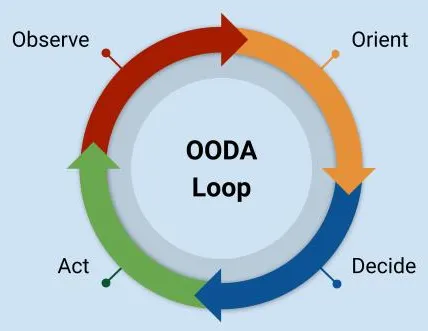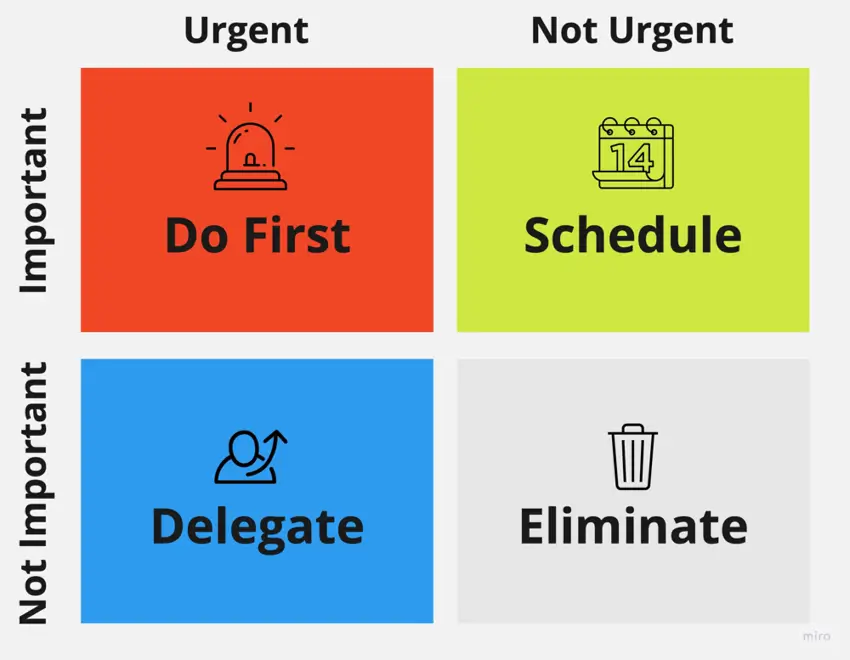Navigating the Technical Leadership Labyrinth: Strategic Thinking and Execution

In the realm of technical leadership, the journey from coder to leader is akin to navigating a labyrinth, filled with intricate pathways and unexpected turns. To traverse this maze effectively, one must master the art of strategic thinking and execution. This installment of our blog series, "Navigating the Technical Leadership Labyrinth," explores two pivotal mental models: the OODA Loop and the Eisenhower Matrix. These frameworks are not mere tools but guiding lights in a leader's odyssey, offering clarity in chaos and agility in action.
The OODA Loop: The Art of Decision-Making in Dynamic Environments
Originally conceptualized by military strategist John Boyd, the OODA Loop (Observe, Orient, Decide, Act) is a model that encapsulates the essence of agile decision-making in rapidly changing environments. It's a cyclical process that enables leaders to continuously adapt their strategies in response to evolving situations.

Observe: The Foundation of Awareness
Observation is the bedrock of effective leadership. It involves not just seeing but perceiving the nuances of your environment - market trends, team dynamics, technological advancements. As a technical leader, you must elevate observation to an art form, gathering data with the precision of a scientist and the insight of a strategist.
Orient: The Compass of Context
Orientation is the process of making sense of your observations. It's about understanding the context, filtering information through your personal experiences, and the collective knowledge of your team. This step is crucial for technical leaders, as it's where your technical acumen intertwines with your understanding of people and processes.
Decide: The Crucial Intersection
Decision-making is the intersection where analysis meets action. In this phase, the leader synthesizes their observations and orientations into actionable strategies. However, this isn't about finding the perfect solution but rather choosing a course of action that aligns with your strategic goals and adapting as needed.
Act: The Bold Leap
Action is where plans are put into motion. It's about implementing decisions with conviction while remaining flexible enough to adjust as you gather new information. For a technical leader, this means leading your team through changes, ensuring that everyone is aligned and capable of executing the strategy.
The Eisenhower Matrix: Prioritizing Tasks for Effective Execution
The Eisenhower Matrix, named after President Dwight D. Eisenhower, is a tool for prioritizing tasks based on their urgency and importance. It's a simple yet powerful way to manage time and resources effectively.

1. Urgent and Important (Do First):
These tasks are both time-sensitive and critical for success. They often involve addressing immediate issues that can impact the project or team, such as fixing major bugs or responding to client emergencies.
Actionable Strategies:
- Implement a rapid response protocol for critical issues.
- Develop a system for assessing the severity of problems to prioritize effectively.
- Enhance communication channels for quick decision-making and action.
2. Important, Not Urgent (Schedule)
Tasks that are important for long-term success but don't demand immediate action fall in this quadrant. These include strategic planning, team development, and learning new technologies.
Actionable Strategies:
- Allocate specific times in your schedule for these activities.
- Set clear, measurable goals for long-term projects.
- Regularly review and adjust your strategic plans to stay aligned with overall objectives.
3. Urgent, Not Important (Delegate):
These tasks require prompt attention but don't significantly contribute to long-term goals. Examples include administrative tasks or some types of meetings.
Actionable Strategies:
- Delegate tasks to team members or use automation tools.
- Develop clear guidelines for what can be delegated and to whom.
- Train team members to handle certain types of urgent but less critical tasks.
4. Neither Urgent Nor Important (Eliminate)
Activities that don’t contribute to your goals and aren’t time-sensitive should be minimized or eliminated. This might include excessive meetings, redundant email threads, or unproductive habits.
Actionable Strategies:
- Conduct regular audits of your and your team's activities to identify time-wasters.
- Learn to say no to requests that do not align with your key objectives.
- Foster a culture that values productivity over busyness.
Applying the Eisenhower Matrix
- Set Clear Priorities: Begin each week by categorizing tasks into the four quadrants. This helps in visualizing where to focus your energies.
- Review Regularly: Circumstances change, and so do priorities. Regularly review your tasks to ensure they are in the correct quadrant.
- Communicate Priorities: Make sure your team understands these priorities. Clear communication can help align everyone’s efforts with the team's objectives.
- Flexibility: While the matrix is a guide, remain flexible. Sometimes, tasks may shift quadrants as situations evolve.
Integrating the OODA Loop and Eisenhower Matrix
Combining the OODA Loop and Eisenhower Matrix creates a robust framework for strategic thinking and execution. The OODA Loop provides the agility to adapt in a fast-paced environment, while the Eisenhower Matrix ensures that your actions are aligned with your priorities.
For a deeper dive into the OODA Loop, see From Chaos to Clarity: How the OODA Loop Can Help You Tackle Any Problem.
Imagine you're leading a team developing a cutting-edge software product. Suddenly, a critical bug is discovered, jeopardizing the project's timeline. Using the OODA Loop, you quickly gather information (Observe), understand the implications (Orient), decide on a course of action (Decide), and implement a fix (Act). Simultaneously, you use the Eisenhower Matrix to prioritize this urgent issue while ensuring that key strategic initiatives, like feature development and team training, are not neglected.
Conclusion: The Dance of Strategy and Execution
The journey of a technical leader is both challenging and exhilarating. By mastering strategic mental models like the OODA Loop and Eisenhower Matrix, you can navigate the labyrinth of leadership with confidence. These models are not just tools but lenses through which you can view the world, enabling you to make decisions swiftly, prioritize effectively, and lead your team to triumph in the ever-evolving landscape of technology.
Remember, the path from coder to leader is not a straight line but a series of loops and turns, each offering lessons and opportunities for growth. Embrace these models as your companions on this journey, and you'll find yourself not just surviving but thriving in the technical leadership labyrinth.

